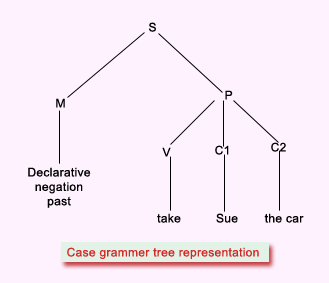|
Case grammars use the functional relationships between noun
pharases and verbs to reveal the deeper case of a sentence.
These grammars use the fact that verbal elements provide the
main source of structure in a sentence since they describe
the subject and objects.
In case grammars, a sentence is defined as being composed
of a proposition P, a tenseless set of relationships among
verbs and noun phrases and a modality constituent M, composed
of mood, tense, aspect, negation, and so on. Thus, a sentence
can be represented as
S à M + P
where p in turn consists of one or more distinct cases C1
, C2, ….., CK,
P à C1 + C2 + ….. + CK.
The number of cases suggested by Fillmore were relatively
few. For example, the original list contained only some six
cases. They relate to the actions performed by agents, the
location and direction of actions, and so on. For example,
the case of an instigator of an action is the agentive (or
agent), the case of an instrument or object used in an action
is the instrumental, and the case of the object receiving
the action or change is the objective. Thus, in sentences
like "The soldier struck the suspect with the rifle butt'
, the soldier is the agentive case, the suspect the objective
case, and the rifle butt the instrumental case. Other basic
cases include dative (an animate entity affected by an action),
factitive (the case of the object or of being that which results
from an event), and locative (the case of location of the
event).
Case frames are provided for verbs to identify allowable
cases. They give the relationships which are required and
those which are optional. For the above sentence. a case frame
for the verb struck might be
STRUCK[OBJECTIVE (AGENTIVE) (INSTRUMENTAL)]
This may be interpreted as stating that the verb struck must
occur in sentences with a noun phrase in the objective case
and optionally (parentheses indicate optional use) with noun
phrases in the agentive and instrumental cases.
A tree representation for a case grammar will identify the
words by their modality and case. For example, a case grammar
tree for the sentence "Sue did not take the car" is illustrated
in the following figure:

|